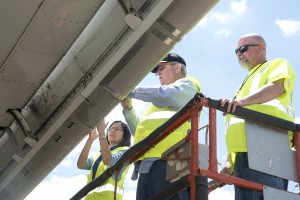For travelers all over the world, the lure of lower airfares is attractive. NASA scientists are working on eliminating a problem that just may drop airfares. Bugs are the target for this new technology. They are developing a coating to be applied to the airplane that will keep insects (and other debris) from sticking to the wings and fuselage of a craft, allowing smoother air flow and lower fuel costs.

Fuel Efficiency
NASA says the improvement in “laminar flow” reduces drag and improves fuel efficiency. Even very small bits of debris, including bug splats, can cause air turbulence that roils the airstream. The scientists describe it as tiny air waves crashing against each other.
Two Potential Coatings
Eliminating the problem would be no small deal. Two potential coatings, tested last year on the wings of a Boeing 757, showed real promise.
The projected savings in fuel costs are enormous.
“It’s like taking your car from 20 miles per gallon to 200,” said Mark Drela, professor at Massachusetts Institute of Technology and a specialist in aerodynamics.
Estimates are that successful coatings could cut airline fuel consumption by 1 percent. If that sounds like a small amount, consider that it represents 167 million gallons of fuel at a savings of 308 million a year.
Those working on the potential coatings say they would be most effective if incorporated into the design of new planes, rather than adding it to craft already in use. And as with all new technologies, it would have to prove itself effective before the manufacturers would run to get on the bandwagon. But environmentalists are pushing, because of the anticipated benefits to the air. Airplanes are blamed for a significant portion of the climate warming that is happening. Amid predictions that more controls will inevitably be placed on the air travel industry (some prospective new regulations are due to be implemented by 2020), they are looking for better solutions.
Expensive Research
The technology being tested borrows a lesson from nature. For instance, they looked at lotus leaves, which has pits and ridges that repel water. The costs of research are enormous. Some $400 million has been spent. Those working on the coatings (at a cost of some $10 million) expect that royalties paid by airlines for use of the technology will recoup their investment.
Future Plans
How soon we will be seeing airplanes with the new coating remains to be seen. And whether it will portend less expensive air fares also is part of the unknown equation. But the prospects are worth thinking about.
While the science is still in its infancy, the prospect offers a number of advantages: less pollution of the air from air flight, (aircraft emit 3 percent of the greenhouse gases in the U.S.) and, down the road, possibly a drop in the cost of air fares.